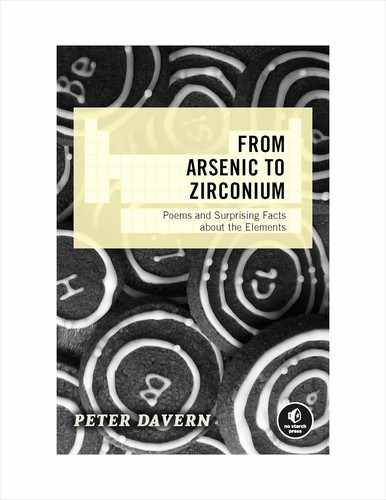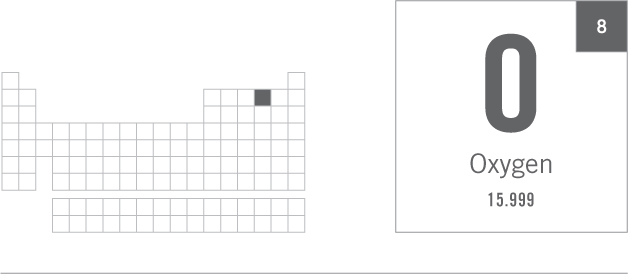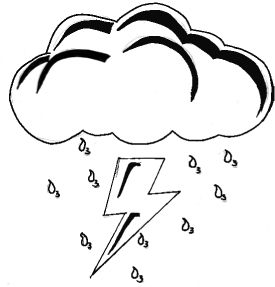OXYGEN, O
THE BREATH OF LIFE
oh-two
O2 bestows each breath of life—this gas, one fifth of air,
THE GASEOUS ELEMENT AT THE TOP OF GROUP 16
Oxygen (as the diatomic molecule, O2) is the colorless, odorless, group 16 gas that makes up about 21 percent of the air you breathe. Breathing anything less than 17 percent O2 for extended periods will impair your physical and mental performance, eventually proving fatal.
Produced through photosynthesis in plants so green and fair.
During photosynthesis, plants use chlorophyll—the green pigment biomolecule—to harness the sun’s energy to convert carbon dioxide (CO2) and water (H2O) to oxygen and carbohydrates.
Most common atom in Earth’s crust,
At 47 percent, oxygen is the most abundant element in Earth’s crust. Much of it occurs as silicon-oxygen minerals or in the moisture (as H2O) present in soil. It also occurs in numerous metal oxides.
Essential when all fuels combust,
A steady supply of air is needed for fuels, such as wood, coal, gasoline, diesel, hydrogen gas, and so on, to burn. In that air, oxygen does all the work, and substances will combust far more vigorously in an oxygen-enriched atmosphere.
you-vee
A vital shield ’gainst sun’s UV—that’s ozone’s fragile layer.
Oxygen (O2) and ozone (O3) are two physical forms, or allotropes, of elemental oxygen. Earth’s stratosphere has a layer of ozone that helps protect you from much of the sun’s ultraviolet (UV) rays; otherwise, those UV rays would harm your body’s cells if they reached you here on Earth. The ozone layer does this by absorbing some of these rays during the continuous formation of O3 from O2 and again by absorbing more of them as this O3 continuously decomposes back to O2.
Unfortunately, this ozone layer is very fragile. It’s particularly vulnerable to breakdown by the chlorine atoms in the chlorofluorocarbons (CFCs) that once proliferated as aerosol, propellant, and refrigerant gases.
oh-two
O2—when liquid—pours pale blue, to bridge magnetic poles.
Oxygen displays the property of paramagnetism. This is a somewhat temporary kind of magnetism that causes the element to be drawn toward an externally applied magnetic field but only for as long as the field is applied. (See “Iron, Fe” on page 74 for further information on paramagnetism.) You can observe this property in action by condensing oxygen gas to a pale blue liquid and pouring it between the poles of a strong magnet. You’ll see it form a liquid bridge between the poles and bubble vigorously as it boils away.
oh-twos
Acetylene-O2’s bright heat through solid steel melts holes.
Acetylene (C2H2) is a highly flammable gas used in blow torches. When mixed with the correct blend of oxygen gas and then ignited, a bright blue flame results that reaches temperatures of 3,100°C—hot enough to melt clean through solid steel.
Should cabin pressure fade away,
see-ell-oh-three
ClO3 sure saves the day!
Sodium chlorate (NaClO3) is a solid, crystalline salt used as the oxygen gas source for oxygen masks on aircraft. A sudden drop in cabin pressure triggers a small, controlled detonation that causes the chlorate to react with some iron filings, producing breathable O2 gas.
Sweet ozone wafts when printers whir, when rumbling thunder rolls.
Printers and photocopiers give off minor spark discharges and charge separations that produce small amounts of faintly sweet-smelling ozone gas (O3) from the O2 in air. You might recognize the smell from lightning storms, which also produce ozone gas for the same reasons, although on a grander scale.


